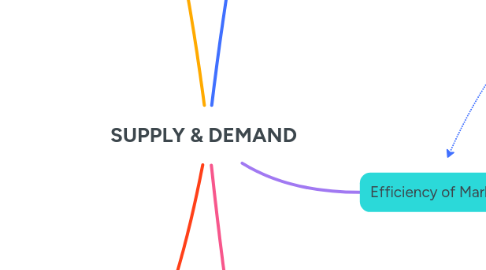
1. Forces
1.1. Affect Demand
1.1.1. P ↑ ↓ Qd
1.1.2. #buyer ↑↑ Qd
1.1.3. Income
1.1.3.1. Nornal good
1.1.3.1.1. Income ↑↑ Qd
1.1.3.2. Inferior good
1.1.3.2.1. Income ↑↓ Qd
1.2. Affect Supply
1.2.1. P.input ↑ ↓ Qs
1.2.2. Cost saving tech→ Qs ↑
1.2.3. #seller↑ → Qs↑
1.2.4. Expectation
2. Elasticity
2.1. Price elasticity of Demand
2.1.1. Peod= Δ%Qd / Δ%P
2.1.2. Forces
2.1.2.1. Subtitutes
2.1.2.2. Necessary or Luxury
2.1.2.3. Broadly/ Closely defined
2.1.2.4. long run: more elasticity
2.1.3. Variety
2.1.3.1. Peod=0 → Perfect inelastic
2.1.3.2. Peod<1 → inelastic (dốc)
2.1.3.3. Peod>1 → elastic (thoải)
2.1.3.4. Peod=1 → Unit elastic
2.1.3.5. Peod=infinity → perfect elastic
2.1.4. Peod & Revenue
2.1.4.1. Elastic: P↑↓ TR
2.1.4.2. Inelastic: P↑↑ TR
2.2. Price elasticity of Price
2.2.1. Peos= Δ%Qs / Δ%P
2.2.2. Forces
2.2.2.1. Easy change Qs, more elastic
2.2.2.2. long run: more elastic
3. Cost of Taxations
3.1. DWL
3.1.1. DWL=1/2 x (Qe-Qt) x ( Pb-Ps)
3.1.2. Tax prevent some beneficial trades
3.1.3. SIze of DWL
3.1.3.1. Depends on Peod, Peos
3.1.3.1.1. Peos ↑↑ DWL
3.1.3.1.2. Peod ↑↓ DWL
3.2. Government
3.2.1. Slabor inelastic → DWL small
3.2.2. S labor elastic → Tax distorting
3.3. DWL & Tax size
3.3.1. Tax ↑, DWL↑ evenmore
3.4. Effects on Market
3.4.1. no tax: Pe, Qe / w. tax: Pb, PS, Qt
3.4.1.1. Tax Revenue= (Pb-Ps)xQt
3.4.1.2. CS= 1/2xQt x (Pmax-Pb)
3.4.1.3. PS= 1/2x Qt x Ps
3.4.1.4. TS= CS+PS+TR
4. Efficiency of Markets
4.1. CS
4.1.1. Willingness to Pay: Pmax buyer will pay
4.1.2. CS= WTP - P = buyer gains
4.1.3. CS↓→ Buyer leave market
4.2. PS
4.2.1. Cost: value given up to produce
4.2.2. PS= P - Cost = sellers gains
4.2.3. PS↓ → seller leave market
4.3. TS
4.3.1. TSmax→ allocation resources efficient
5. Government Policy
5.1. Price ceiling (maxP)
5.1.1. Rent control
5.1.2. Affect Market
5.1.2.1. Pc<Peqm → shortage
5.2. Price floor (minP)
5.2.1. Minimum wage
5.2.2. Affect Market
5.2.2.1. Pf > Peqm → surplus
5.3. Taxes
5.3.1. To pay national defense, public school,etc.
5.3.2. Tax on buyer
5.3.2.1. D curve down → New eqm
5.3.2.1.1. wedge P buyer pay & P seller receive
5.3.3. Tax on seller
5.3.3.1. S curve up
5.3.4. Elasticity & Tax Incidence
5.3.4.1. D inelastic, S elastic
5.3.4.1.1. Buyers bear most of the burden tax
5.3.4.2. D elastic, S inelastic
5.3.4.2.1. Sellers bear most of the burden of the tax
